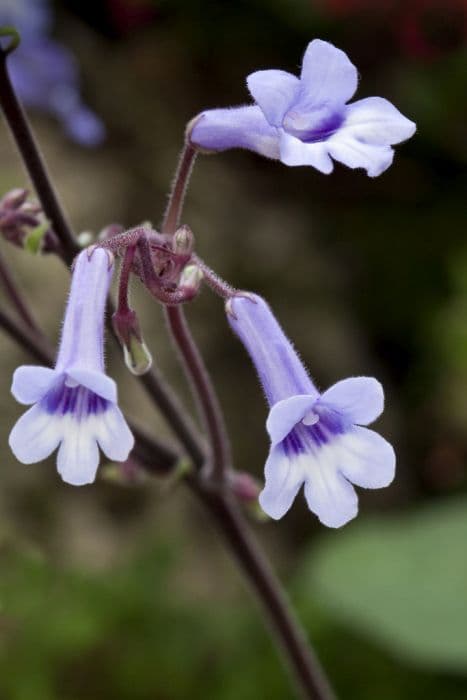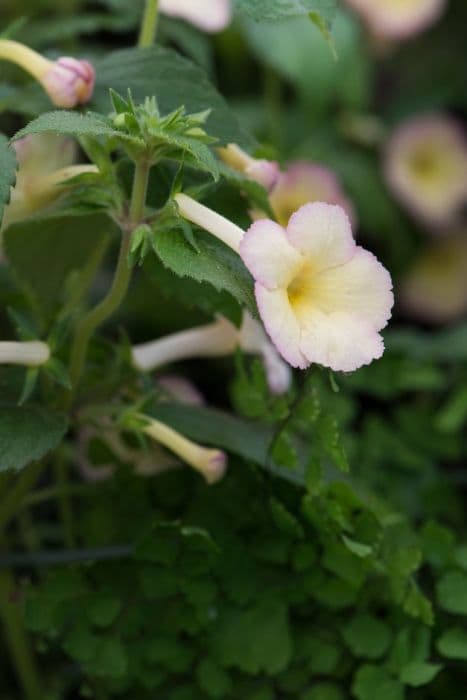Cape primrose Streptocarpus wendlandii

ABOUT
Streptocarpus wendlandii is a striking plant with lush, velvety leaves that emerge in a rosette formation, spreading outwards in a circular pattern from the center. The leaves are deep green, elongated, and have a soft, almost furry texture, adding to their plush appearance. Each leaf is quite substantial, with prominent veins that run the length of the leaf, creating a textured surface that is visually appealing. The plant is known for its beautiful flowers that blossom in clusters on tall, slender stalks that arise from the base of the rosette. The flowers are typically a shade of violet or purple, though some variations may occur. They possess a trumpet-like structure, with a flared mouth that opens up to reveal delicate, lower lips marked with intricate patterns or spots that add to their ornamental quality. These blossoms contrast elegantly against the foliage, creating a vibrant display that is eye-catching and serene in equal measure. Streptocarpus wendlandii flowers are not only appreciated for their beauty but also for their delicate, pleasing aroma that can add a subtle fragrance to the area around them. The flowering period adds a dynamic element to the plant's appearance, showcasing its ability to change and evolve throughout the growing season. Overall, the appearance of Streptocarpus wendlandii is characterized by its lush foliage and showy blooms, which combine to create an attractive and rewarding plant for gardeners and indoor plant enthusiasts. Its ornamental traits make it a popular choice for adding a touch of natural elegance to various settings.
About this plant
 Names
NamesFamily
Gesneriaceae
Synonyms
Cape Primrose, African Violet
Common names
Streptocarpella wendlandii.
 Toxicity
ToxicityTo humans
Streptocarpus wendlandii, commonly known as Cape primrose, is not known to be toxic to humans. There is limited information suggesting that it could cause harm if ingested, but as with any non-food plant, it is advisable to handle it with care and avoid ingestion as a general safety precaution. There are no widely recorded symptoms of poisoning from the Cape primrose, as it is not commonly regarded as a poisonous plant.
To pets
Cape primrose is not listed as a toxic plant for pets, including cats and dogs. There is no significant evidence to suggest that Streptocarpus wendlandii poses a risk of toxicity to pets when ingested. However, although it is considered non-toxic, pets should not be encouraged to eat this or any ornamental plant, since doing so can potentially lead to gastrointestinal upset or other non-toxic related symptoms due to the ingestion of plant material not typically part of their diet.
 Characteristics
CharacteristicsLife cycle
Perennials
Foliage type
Evergreen
Color of leaves
Green
Flower color
Blue
Height
1 foot (30 cm)
Spread
2 feet (61 cm)
Plant type
Herb
Hardiness zones
10
Native area
Africa
Benefits
 General Benefits
General Benefits- Easy Care - Streptocarpus wendlandii, commonly known as Cape Primrose, is relatively low-maintenance and can thrive with minimal care in proper conditions.
- Ornamental Appeal - With its beautiful velvety leaves and striking flowers, it adds an aesthetic charm to any indoor space.
- Long Flowering Period - Cape Primrose often blooms for a long time, sometimes throughout the year in ideal conditions, providing continuous color and interest.
- Compact Size - Its compact growth habit makes it suitable for small spaces such as apartments and office desks.
 Medical Properties
Medical PropertiesThis plant is not used for medical purposes.
 Air-purifying Qualities
Air-purifying QualitiesThis plant is not specifically known for air purifying qualities.
 Other Uses
Other Uses- Streptocarpus wendlandii leaves can be used in the art of leaf casting to create detailed, ornamental sculptures for garden decoration.
- The large leaves of the Cape primrose can serve as subtle natural wrappers for small gifts or trinkets, embodying an eco-friendly packaging option.
- In educational settings, the Cape primrose can be utilized for botanical studies due to its interesting foliage and growth habits.
- Cape primrose's vibrant flowers can be used as a natural dye source for fabrics and other materials, offering various shades of blue and purple.
- The flowers are sometimes used in botanical photography due to their intricate patterns and striking colors, which provide excellent practice for macro photography techniques.
- Hobbyist plant breeders may use Cape primrose to create hybrid varieties with other Streptocarpus species, expanding the diversity of houseplants.
- The plant can be part of a terrarium setup, especially large terrariums, adding to the visual appeal with its lush foliage and blooms.
- As a subject of time-lapse videography, the blooming cycle of the Cape primrose can make for captivating footage that showcases the dynamics of plant growth.
- The plant's non-toxic nature makes it safe for use in classrooms and homes as an educational tool for teaching children about plant care and life cycles.
- Lastly, Cape primrose can be featured in artistic compositions and still-life photography where its form and color complement other elements in the art piece.
Interesting Facts
 Feng Shui
Feng ShuiThe Cape Primrose is not used in Feng Shui practice.
 Zodiac Sign Compitability
Zodiac Sign CompitabilityThe Cape Primrose is not used in astrology practice.
 Plant Symbolism
Plant Symbolism- Persistence - Streptocarpus wendlandii, commonly known as Cape primrose, often symbolizes persistence due to its ability to thrive with minimal care, making it a metaphor for enduring through difficult conditions.
- Resilience - Cape primrose's capacity to rebound from neglect and still produce beautiful flowers represents resilience and the ability to recover from challenging situations.
- Adaptability - The adaptability of the Cape primrose, able to grow in various environments, often symbolizes the ability to adapt to changing circumstances in life.
- Longevity - With proper care, Cape primrose plants can live and bloom for several years, representing the concept of longevity and long-lasting endeavors in one's life.
- Beauty and Hope - The lush foliage and vibrant flowers of the Cape primrose symbolize beauty and hope, providing a sense of optimism and positivity.
 Water
WaterCape primrose, or Streptocarpus wendlandii, prefers consistent moisture but does not like to sit in waterlogged soil. You should water your plant when the top inch of the soil feels dry, which typically equates to once a week, but this can vary depending on the humidity and temperature in your home. Use room-temperature water and gently pour it around the base of the plant until it begins to drain out the bottom—this could be approximately 8-16 ounces for a standard potted plant. During the winter months, reduce watering slightly, as the plant's growth slows down.
 Light
LightCape primrose thrives in bright, indirect light. Place it near an east-facing window where it can receive gentle morning sunlight without exposure to harsh midday rays. A northern window with consistent but softer light is also suitable. Avoid placing the Cape primrose in direct sunlight, especially during the hottest parts of the day, as this can scorch its leaves and cause damage.
 Temperature
TemperatureCape primrose prefers temperatures between 60 to 75 degrees Fahrenheit for optimal growth. It can survive minimum temperatures down to about 50 degrees Fahrenheit but ensure to protect it from frost. Extreme heat above 80 degrees Fahrenheit can stress the plant, so it's best kept in a controlled indoor environment if you're living in a hotter climate.
 Pruning
PruningTo encourage bushier growth and more blooms, prune your Cape primrose after it flowers. Remove spent flower stems and yellowing leaves to promote new growth. Pruning is typically done after a flush of blooms is over or when the plant appears leggy, usually once every few months. The best time for pruning is late winter or early spring before the new growth cycle begins.
 Cleaning
CleaningAs needed
 Soil
SoilCape primrose prefers a well-aerated soil mix, consisting of peat moss, perlite, and vermiculite in equal parts. It thrives in slightly acidic to neutral pH, ranging from 6.0 to 7.0.
 Repotting
RepottingCape primrose should be repotted annually to refresh the soil and accommodate root growth, ideally in spring or early summer.
 Humidity & Misting
Humidity & MistingCape primrose flourishes in moderate to high humidity, with ideal levels ranging around 50-60%.
 Suitable locations
Suitable locationsIndoor
Place in bright, indirect light; keep soil moist.
Outdoor
Shelter from direct sun; protect from frost and excessive rain.
Hardiness zone
10-11 USDA
 Life cycle
Life cycleCape primrose (Streptocarpus wendlandii) begins its life cycle when seeds germinate in moist, well-draining soil, typically in shady conditions. After germination, it develops a rosette of elongated leaves from which it will produce flowering stalks. The flowers are large and showy, usually blue or violet, attracting pollinators for sexual reproduction. Following pollination, the plant produces dry, dehiscent fruit capsules which contain numerous tiny seeds. When the capsules mature, they split open to disperse the seeds, thereby completing the reproductive cycle. In ideal conditions, Cape primrose may continuously bloom and produce seeds, but it is also capable of vegetative reproduction through leaf cuttings, enabling the plant to spread and grow clonally.
 Propogation
PropogationPropogation time
Spring-early summer
Streptocarpus wendlandii, commonly known as Cape Primrose, can be propagated most effectively through leaf cuttings, a popular method due to its simplicity and high success rate. To propagate by leaf cuttings, a healthy, mature leaf is selected and cut across the width into sections, each section containing a vein. These sections are then placed right-side up on a moistened mixture of perlite and peat moss, ensuring that the cut edge is in contact with the substrate. The environment should maintain high humidity, which can be achieved by covering the setup with a clear plastic bag or container, and kept in bright, indirect light at around 70 degrees Fahrenheit (about 21 degrees Celsius). Roots typically develop within a few weeks, followed by new shoots, at which point the new plants can be gently removed and potted individually.









